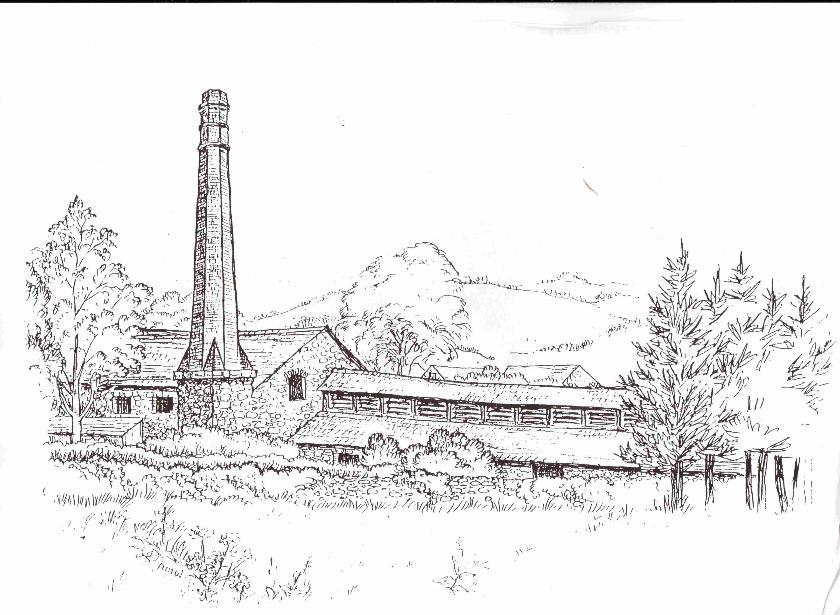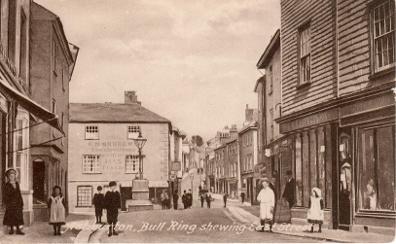Occupations 1800s

Above: The Umber Works tower, Chuley Road (now demolished)
My thanks to the Peggy Wakeham and Robert Wakeham for the above drawing.
*******
Names and occupations from documents connected to the Palk family of Haldon, in the Devon Heritage Centre. Ref Z10:
1800
Peter Wotton, cordwainer
1802
John Furneaux, malster
1820
John Furneaux, victualler, eldest son of John Furneaux late of Ashburton, malster, dec'd.
1832
Margaret Pears (wife of Edward), formerly the widow of George Monday of Ashburton, cordwainer, dec'd.
*******
27th July 1812 Richard Widdicombe was bound apprentice by the churchwardens to William Widdicombe of Ashburton
Stated in the case of The churchwardens and overseers of the parish of Staverton against the churchwardens and overseers of the parish of Ashburton January 17th 1855
On 29th February 1820 John Waldron, aged 12, was apprenticed to Stephen Yolland of Ashburton, yeoman
Stated in the case of The Queen v the inhabitants of Ashburton, April 29th, 1846
From English Reports, http://www.commonlii.org/uk/cases/EngR
*******
Dartmoor, a Descriptive Poem, N T Carrington, London 1826, p152
*******
In 1827 The following businesses were mentioned in a report of a fire (for details see the Fire and Flood section under Ashburton in Peril):
Mr. Caunter's factory
Mr Mann's tan-yard
Mr Hern's tan-yard
Exeter Alfred, reported in Palmer's Index to The Times, 5 July 1827, p2 col6
*******
In 1828 Mr Hern's tan-yard, outhouses and offices in St Lawrence Lane were put up for sale, together with a dwelling house.
Exeter and Plymouth Gazette 29 March 1828 p1 col2
This might be the same tan-yard, cottage, garden and premises, described as being in the centre of Ashburton, that was for sale 2 years later. The yard had a stable, leather-house, barn and outhouses for keeping bark and equipment included:
36 handlers under cover
9 troughs,
13 letches
A beam house, covered with soaks
watering pits
large drying lofts
A pound house for grinding bark
There was a stream running through the property which kept the yard supplied with water.
Western Times 31 July 1830 p1 col4
A tan-yard for sale in 1854, known as The Old Mill, had been occupied by Mr Evans.
It was described as having
A water pit
5 lime and 83 tan pits
Drying lofts sufficient for 300 hides
An improved bark mill and lifting pumps
Extensive bark barn
Exeter Flying Post 20 April 1854 p1 col1
*******
6 academies
5 attorneys
3 auctioneers
7 bakers
1 bank
5 boot and shoe makers
4 cabinet makers
3 carpenters
1 carver and gilder
1 confectioner
2 coopers
1 corn dealer
2 curriers
5 drapers
2 druggists
7 fire offices
1 hatter
2 inns
2 ironmongers
3 maltsters
2 painters etc.
1 printer
3 saddlers
5 surgeons
5 tailors
3 tanners
15 taverns
1 turner
3 watch and clockmakers
4 wheelwrights
4 woollen manufacturers
1 woolstapler
*******
Western Times 6 May 1848 p6 col5
*******
1851 Thomas Gillard was a member of the Pharmaceutical Society of Great Britain
Pharmaceutical Journal, vol 10, 1850-51, Ed Jacob Bell, London, 1851, p374
*******
Ashburton Museum
1891 census Ashburton, West Street shows John I Lamason, a widower, a brush maker.
In 1911 John Isaac Lamason is living with his wife Lavinia at 1 West Street.
In an article on Ashburton Museum in 1976, W R Hatch (joint curator at the time) wrote about the present building at 1 West Street: ' ...was the property of Lord Cranstoun and passed through Margaret Macleod, Baroness de Virte de Rathsamhausen to John Isaac Lamason in 1893.......John Lamason was a brush manufacturer and his name still shows through the paint on the facia. In the attic (access to which has now gone....) there was a window and perhaps family or apprentices' sleeping quarters behind oak panel doors'
The Devon Historian, October 1976, no 13, W R Hatch p 27
*******
G H Andrews
When George Henry Andrews died in January 1939 he was described as one of the oldest tradesmen in the town. Aged 75, he had been a baker and confectioner up until three years before he died. He had been a member of both the Freemasons and the Constitutional Club.
When the amount of his estate was published in March (£1717 gross), his address was Roscoe in North Street - No 5 according to English Heritage.
But earlier, around the turn of the century, a postcard shows him trading at No 2 North Street - see below.
Western Morning News 30 January 1939 p3 col3
Western Morning News 27 March 1939 p4 col3
http://list.english-heritage.org.uk - Accessed 2-7-2014

From my own collection
*******
In 1829 the Manor or Town Mills were put up for sale, together with a dwelling house, courtlage*, outhouses, garden and meadow. They were grist or flour mills in North St., occupied at that time by Mr Osmond, and were part of a 'three lives lease' of a maximum of 99 years - the ages of the people whose lives determined the length of the lease were 32, 16 and 2. There were various conditions to the sale, including rebuilding the mill and house within 5 years; the purchaser also had to pay an annual sum of £10 to the poor of Ashburton.
Exeter and Plymouth Gazette 9 May 1829 p1 col 2
*See Terms Used in Property Documents in the sub-menu of People and Properties
There is more on mills in The Mills, another sub-menu of this section (Banks and businesses)
********
In 1830 a quarter of a messuage or tenement was put up for sale, called Reeves's or Mardons. Situated near North St., and occupied by Mr Berry, it consisted of a bakehouse, 2 chambers and outhouses
Exeter and Plymouth Gazette, 24 July 1830 p1 col 5
*******
In 1842 Lower Mead Farm was put up for sale, after the death of Mr Stephen Yolland. It consisted of a farm house and 86 acres of land, including an orchard. It was also sold with a lime kiln and lime rock, which were on the road from Ashburton to Mead, within half a mile of the farm house, and close to the turnpike road.
Exeter and Plymouth Gazette 8 October 1842 p1 col2
In 1842 Lurgecombe grist and flour mill was sold by Mr John Pearce, a selling point being that an 'excellent' corn market was held in Ashburton. The lease was for the remainder of 99 years, and the 'three healthy lives' were aged 53, 14 and 11. Included in the sale were 2 pairs of stones, a bolting mill, a smut machine and corn hutches.
Western Times 5 March 1842 p1 col2
*******
The 1851 census shows Edward Coysh as a blacksmith in St. Lawrence Lane, where he is living with his wife Elizabeth and children Charlotte and Charles.
Census 1851 HO107, Piece: 1871, Folio: 271, p 24
1853. The Western Times reported that Mr E Coysh, blacksmith, had completed an order for 1600 horse shoes, to be sent to Melbourne, Australia.
Western Times 26 March 1853 p5 col4
*******
Properties and businesses mentioned in an item in 1854, about a fire in Back, ie Stapledon Lane:
A property belonging to Mr Robert Bowden
A barn and dwelling of W F Down, tea dealer
The property of Mr Norrish, dairyman.
For details of the fire, see the Fire and Flood section, under Ashburton in Peril
*******
Western Times 12 July 1856 p7 col3
*******
In 1867 a price war broke out amongst the butchers. Charles Yolland began by lowering the price of mutton to 5 and a half pence per pound. Shortly afterwards the 'crier' announced that Mr T Pearce was selling mutton at 4 and a half pence. Mr Smerdon, who operated the adjacent stall to Mr Pearce in the market, then sold 'good joints' at a halfpenny lower still.
Exeter and Plymouth Gazette 27 November 1867 p7 col5
* ******* *
History, Gazetteer and Directory of Devon, William White, Sheffield 1878-79, p37
*Now called the Ashburn
*******
22nd December 1882 Mortgage of Thomas Pearse, baker of Ashburton, to Robert Francis of Newton Abbot, gent.
Ref. 2378/5/9 Held by the North Devon Record Office
http://discovery.nationalarchives.gov.uk
Western Times 8 November 1889, p7 col1
PCC Wills
The highest court for the south of England was the Prerogative Court of the Archbishop of Canterbury - hence PCC wills
Copies of PCC wills are kept at the National Archives -
http://www.nationalarchives.gov.uk/. You can find full references on the website, and order copies online. Alternatively you can visit the archives and view the wills for free
Occupations in Ashburton PCC wills (extracted from fuller list in the People and Properties section)
I have included 'Yeoman' as an occupation, but not 'Gentleman'
James Spark, butcher, October 1801
Thomas Searle, soap boiler, October 1809
George Maye otherwise, May, taylor, February 1812
Roger Maunder, cordwainer, November 1822
John Higgins, leather factor, May 1824
William Bowden, victualler, January 1839
Solomon Tozer, maltster, May 1844
George Casely, tailor, October 1846
Richard Perry, yeoman, February 1847
Robert Abraham, solicitor, April 1847
William Ferris Honywill, schoolmaster, July 1850
William Eales, clerk, January 1855
*******
Scavengers
In a letter to the Exeter and Plymouth Gazette in April 1870, a correspondent signing himself (or herself) Shopkeeper, complained about the scavenger of the town.
Getting the streets swept was of importance to shopkeepers, the writer complained, yet the scavenger 'sweeps when he likes'. 'When he likes' that morning had been at ten o'clock, with dust flying about East Street and filling the shops.
The shopkeeper had tackled the Surveyor about the problem, and suggested the use of the water-cart, only to be informed that the cart was locked away.
Exeter and Plymouth Gazette 8 April 1870 p8 col5
In the 1911 census 78 year old William McDowell put down his occupation as 'Scavenger UDC.'